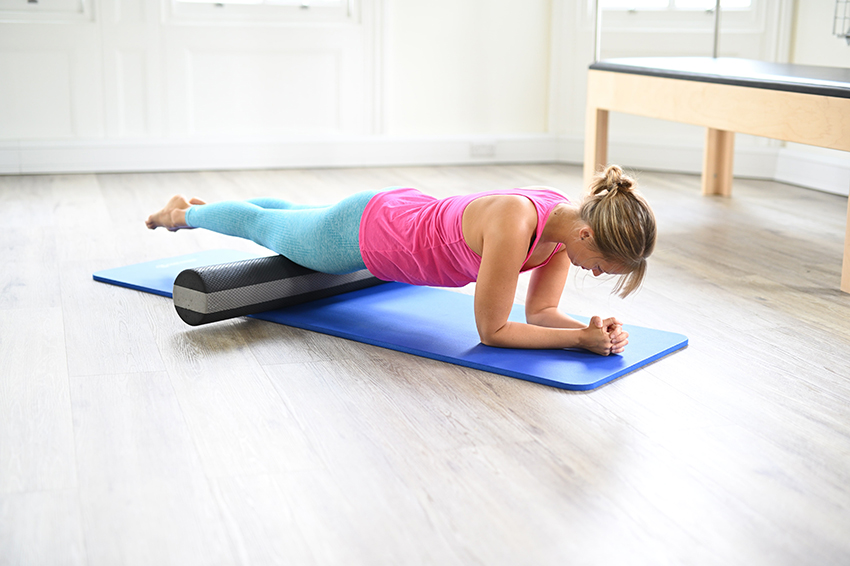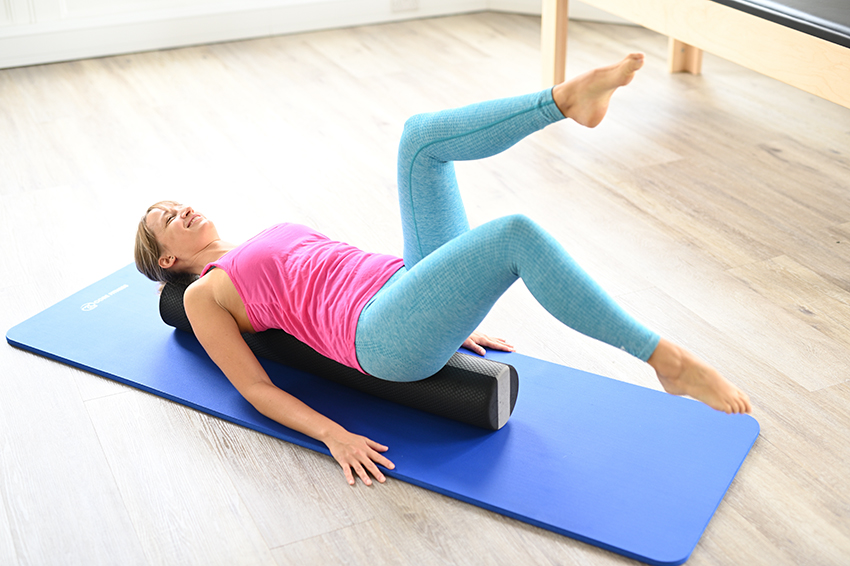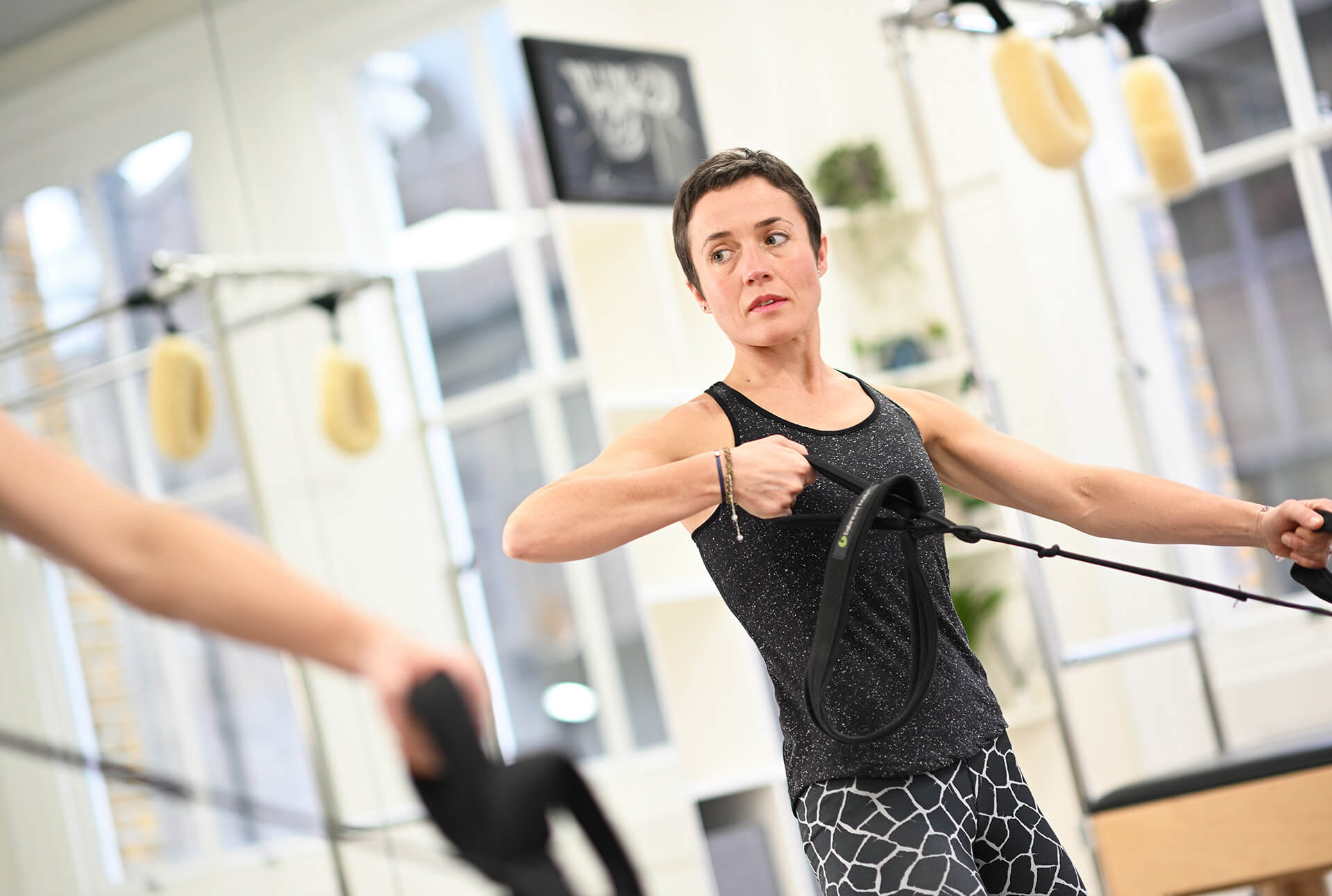If you are a runner who likes to run regularly or cover long distances, then it’s likely that over time you’ll suffer from knots and tight spots in your body. This often comes hand in hand with not varying your training programme and not doing mobility or strength exercise like Pilates.
If that’s that case then foam rollers exercises for runners can help! They not only help to release the pressure built up within the body but also give the muscles some much needed TLC.
Foam rollers help to increase mobility and flexibility which are both important for running efficiently and effectively. They’re also highly rated by physiotherapists and clinical Pilates instructors as they are a great way to assist with rehab related to a running injury.
In this article, we’ll be discussing:
- What is a foam roller?
- What are the benefits of using a foam roller for runners?
- When should runners use a foam roller?
- Foam roller exercises for runners
- Foam roller mistakes to avoid
- Who should avoid using a foam roller?
- Why should runners do foam roller exercises
What Is A Foam Roller?
A foam roller is an effective recovery and performance tool that offers a form of soft tissue massage. Foam roller exercises for runners help work out those tight spots caused by pounding the streets or athletics track by using the pressure created from body weight. They also increase blood flow and circulation, and help to mobilise scar tissue to speed up recovery from injury.
The majority of foam rollers are long cylinder shaped tubes made from a dense foam called EVA. The density of the foam used can generally be identified by its colour with black being the densest and white being the softest. However, over the years they have been developed and can now come in many different shapes, sizes and textures depending on an individual’s needs and performance goals.
What Are The Benefits Of Foam Roller Exercises For Runners
Not only is foam rolling a great way to mobilise and stretch tired muscles after a run, it can also contribute to becoming a better overall athlete and runner and can help to prevent running injuries.
Benefits Of Runners Using a Foam Roller:
- They offer a form of self-massage to help increase range of motion and flexibility – which in turn will help improve running stride.
- They can help work out knots and tension built up in the body caused by running.
- Can help reduce muscle soreness after working out.
- They can help stimulate blood flow which allows more oxygen to be delivered to sore muscles.
- They can help when recovering from a running injury.
Related reading: Is Pilates good for running?

When Should Runners Use A Foam Roller?
In order to be a ‘healthy’ runner, runners should really be incorporating an effective warm up and cool down routine into their programme. This can be done using foam roller exercises.
Foam roller exercises pre-run can help to boost circulation and increase blood flow to get the body ready for a workout whilst post run foam rolling can help flush out any toxins and aid recovery.
If time is short, just 10 minutes of foam rolling as part of a bedtime routine can help ease those muscles.
Foam rolling can also be used in other parts of running training too. It can be used as a great way to challenge the core – which is so important for posture and stability in running – or it can be used in separate mobility practices to help increase range of movement in the body and improve strength, coordination and control overall.
The best way to understand how to use them and how they can help support your running or specific goals is to book in a 1-2-1 session with a Physio or Pilates teacher who’ll be able to give you the best advice.
Foam Roller Exercises For Runners
Below are 5 of the best foam rolling exercises for runners:
1. Runners single leg stretch
This is a great exercise for runners to challenge the core whilst coordinating the arms and legs.
You need a long 90 cm roller aligned length ways down your spine so that your head is on it.
Find your neutral spine position and float one leg at a time into the tabletop position. Take some breaths and ensure you are maintaining the neutral spine.
Lift one arm up and maintain your balance, reach the opposite arm and leg away straightening the leg and reach the arm overhead. As you reach the leg long point the toes, this replicates the push off phase of your running gait. As you bring the knee to chest flex the toes.
Single leg stretch top tips;
- Reach all the way through the full range of movement so that the leg goes as straight as you can
- Breathe through the movement so use the full core effectively
- If it feels difficult to maintain a neutral spine or you are getting back pain, modify by resting one foot on the floor as you do it so that you only work one side at a time.
2. Swan back strength for runners
Having good posture and endurance of your postural muscles helps running efficiency and economy. This means that you can run better for longer if your posture is better. This Pilates swan exercise can help!
You need a long 90 cm foam roller.
Lie on your front with the roller under your arms just below the elbows. Draw your shoulder blades gently back towards each other as you hover your head and chest up off the floor. As you lift draw the roller in towards you and bend and straighten the elbows to move the roller in and out as you stay lifted.
Repeat 5 times before lowering back down and then repeating the whole move again.
Top tips for swan back strength;
- Imagine you are pulling the arm bones into the sockets of the shoulder
- Reach the legs away long and press the back of the feet down to the floor
- Keep the pubic bone of the pelvis pressing towards the floor to help you maintain neutral spine
- Keep the head hovering up in line with the rest of the spine
3. Foam roller jack knife for runners
This is a high-level challenge for your core and the coordination of your legs and body. It works all areas of the body at the same time.
On all fours place the roller underneath the ankles. Check your alignment in this Pilates quadruped position with the spine in neutral and head in line with spine.
Hover the knees off the floor, your weight will come further forwards than normal through the wrists. Aim to keep light through the wrists by pressing into the floor with hands and roller with feet and floating the body up.
Lift one foot off the roller and pull the knee towards the chest. At the same time reach the foot on the roller away so that you roll the foam roller away from you. Pull that leg back in towards your chest and reach the floating foot away long.
Repeat X 5 each side and do three sets.
Top tips for Jack Knife on the foam roller
- Breathe through the movement
- Start with a small range and gradually try and increase it
- Aim to keep the spinal alignment throughout so that you are not flexing and extending the spine – can you keep the spine stable and the legs move?
4. Standing run with the foam roller
This is a great way to get those core muscles activating in standing.
Stand with the roller to one side and slightly in front of you. With one hand on the roller press down into it as you stand tall and float one knee towards your chest. Bring the opposite hand up as well. Move the arm and leg in an exaggerated run motion whilst trying to keep the body still and tall. Repeat on each side.
Top tips for the standing run foam roller exercise
- You can build up the endurance on this with time rather than reps.
- Take a video or check the mirror to see if you are keeping the body still
- Pressing down on the roller you should feel the muscles in your side, back and abs switch on.
- Press into the foot on the floor as well to lift tall out of the standing hip and activate the glutes.
5. Foam roller release exercises
Here we have the foam roller release series for glutes, quads, hamstring and ITB. Use these after a run as part of your warm down or regularly during the week to keep your soft tissues mobile.
The hamstrings
The quadriceps
The glutes
The ITB
Foam Roller Mistakes To Avoid
Whilst foam rolling is an effective and safe tool for runners, there are a few mistakes you should avoid:
Rolling On An Injury
Injured muscles can be damaged – they’re strained, torn, or overloaded. For that reason, they can be inflamed. And too much foam rolling could increase inflammation and tension in the area. This is the same principle as not massaging over bruised areas.
Rolling Too Quickly (Or Too Long)
Like any type of massage, you can use a foam roller for too long, too little, or use it too aggressively.
Set a time limit of a few minutes per major muscle. Use slow, controlled, and deliberate movements over the roller rather than quick, fast movements. And if you find an area that’s particularly sore, tight, or painful, you can spend an extra 20-45 seconds pressing on the sensitive area. But don’t spend much longer than that as you could cause more irritation.
Who Should Avoid Using a Foam Roller?
Foam rolling is generally considered safe if you have muscle tightness or you run regularly. However, we would recommend you avoid using a foam roller if you have a serious injury such as a muscle tear or break, unless you have spoken to your doctor or a physiotherapist.
Why Should Runners Do Foam Roller Exercises?
No matter if you run every day or run once a week, foam rolling exercises are a great way to help reduce your risk of injury, improve your mobility, and reduce muscle soreness.
At Complete Pilates, we would always advise you to speak to your doctor, physiotherapist, or clinical Pilates instructor here at Complete Pilates if you are worried about using a foam roller for the first time or have an injury which you are worried about. We are trained to safely treat and create manageable plans to keep you healthy.
Get in touch online or contact us on 0203 764 5668 for further information and advice!
You can find us at one of our Pilates studios in London and speak to us about your needs. You can find us at our studios below:
Education is key:
These blogs are designed to give information to everyone, however, it is important to remember that everyone is different! If you have not seen one of our therapists and have any questions about injuries, what you have read or whether this may be useful to you, please just ask. We are more than happy to help anyone and point you in the right direction. Our biggest belief is that education is key. The more you understand about your injury, illness and movement, the more you are likely to improve.




